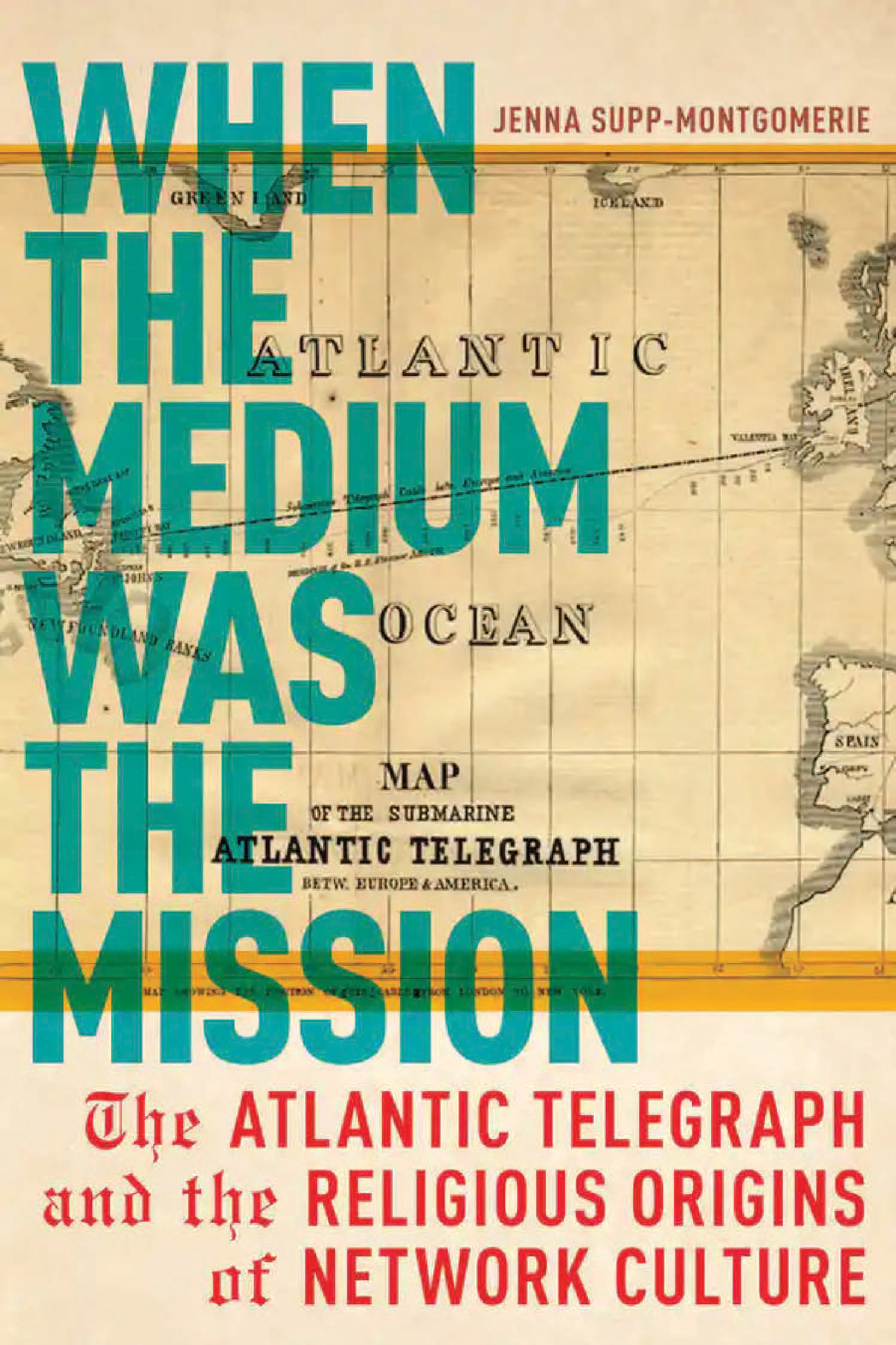In 1858, after much fanfare, the Atlantic cable was successfully laid between Newfoundland and Ireland. The cable functioned only for a few weeks before all communications ceased, and it currently lies, disintegrating, on the ocean floor. Why does this broken historical blip of a telegraph cable matter? As Jenna Supp-Montgomerie demonstrates in When the Medium Was the Mission: The Atlantic Telegraph and the Religious Origins of Network Culture, it was the deeply held desire of American Protestants to bring about global unity—and they understood this early attempt at a transatlantic telegraph and creating a networked culture to be vital to their mission. US Protestants in this period became obsessed with the possibility of the global village, with collapsing space and time, and with the promise and potential of instantaneous, uninterrupted communication. Of course, the 1858 cable did not actually make any of that possible. However, in the public imagination, the cable and the network it would create made all things possible. As Supp-Montgomerie argues, religion, and particularly US Protestantism, “forged an imaginary of networks as connective, so much so that we broadly define networks as systems of connection.”2 When the Medium Was the Mission explores how that imaginary came to be forged and what the consequences are of imagining networks as connective when they are, by their very infrastructure, as much about disconnection as connection. Networks fail all the time—in 1858, and even now. The reason for our collective obsession with the imaginary of connection becomes clear only when we place questions about religion and its relationship to infrastructure and the materiality of networks at the center of our analysis. As Protestantism diffused into US culture, the drive to connect the world via cables became deeply spiritually inflected—even by those who were not “religious” actors—and that inflection fundamentally shaped not only how networks would operate but how we would think about them. Supp-Montgomerie’s work therefore demonstrates the importance of religion to studies of media infrastructures and industries: sometimes, it lurks so close to the surface that it becomes unremarkable. Remarking upon it, however, is the best way to make strange the discourses around media technologies that we often take for granted.
When the Medium Was the Mission begins with the Ottoman Empire to provide crucial context for how the telegraph became inextricably tangled up in religion (chapter 1), as US Protestantism itself was changing in the mid-nineteenth century. By looking abroad, Supp-Montgomerie reveals why US missionaries understood the telegraph as a central part of their mission. They saw the technology as having its own power; power that was capable of changing minds and hearts on its own. More importantly, she demonstrates how the Christian trope of the “neighbor” expanded with the introduction of the telegraph and the imaginary of a global village in which everyone is your neighbor. The telegraph’s fascinating backstory is incomplete without attending to its disconnections, failures, and fractures, including the role the telegraph played in the fall of the Ottoman Empire, which transpired shortly after Christian missionaries gifted the sultan with the technology.
Chapter 2 asks why, out of all the meanings of “telegraph” that were circulating in the 1850s, did the electromagnetic telegraph so quickly emerge as the telegraph? This chapter does a historical deep dive and examines all the other “telegraphs”: including the slave ship Telegraph, the grapevine telegraph, the spiritual telegraph, and the optical telegraph. It delves into why each of these alternative “telegraphs” did not or could not capture the national imagination as the Atlantic cable did. As Supp-Montgomerie argues, these telegraphs faded into history because of the affective weight that US public Protestantism brought to the electromagnetic telegraph and its potential to create a global neighborhood.
Supp-Montgomerie’s impressive archival work shines in chapter 3, which analyzes one particular religious group, the Oneida Community of upstate New York, and their overwhelming enthusiasm for the 1858 cable. The Oneidans were a utopian group who believed that moral perfection was possible in the present; they understood the Atlantic cable, despite its propensity for failure, to be a clear harbinger of that perfect present. Through a discourse analysis of several different Oneida publications, Supp-Montgomerie demonstrates how the Oneidans’ love for the cable echoed the broader techno-utopian discourses that were so popular in the mid-nineteenth century and reminds us that techno-utopianism was and is inherently religious.
Chapter 4 takes the cable’s messages as its focus, particularly those “stutters” which failed to signify any meaning (in the linguistic sense). Supp-Montgomerie uses this chapter to demonstrate the particular usefulness of an “infrastructural” approach to media and communication studies, by contrasting it with structuralism (via Saussure) and poststructuralism (via Lacan). This approach offers a way to understand how the stutters (the “V” signals that the operators sent back and forth to reestablish connection) were made meaningful by those religiously invested in the success of the cable because they, even in their meaninglessness, established protocols for communication beyond the terms of typical representation. They made the technology visible. The book closes with a brief consideration of the telegraph’s ties to the infrastructure of the internet, and Supp-Montgomerie offers up “resonance” as a framework for understanding the relationship between the wires of the 1850s and the wires of today. It is not, of course, a one-to-one connection. However, our shared cultural imaginary of networks as public, national, global, politically neutral, technological, and most of all connective can be traced all the way back to the American public Protestantism of the 1850s.
Interdisciplinarity is one of Supp-Montgomerie’s particular strengths in this book. When the Medium Was the Mission cleverly blends history (including impressive archival finds) and theory from several fields, such as communication studies, media studies, history, and religious studies. As the preceding summary makes clear, this book covers a lot of material. Nevertheless, the main themes are clear throughout, and the disparate chapters are connected by Supp-Montgomerie’s primary argument: that religion has fundamentally shaped network culture. The book’s originality comes primarily from Supp-Montgomerie’s attention to materiality and her insistence that there is much to be learned by thinking about the relationship between religion and media beyond analyzing religious content or thinking of different media as mere delivery systems for religious messaging. She makes a strong case that the American public Protestantism of the 1850s was the driving force behind Americans’ investment in networks and network culture as connective. Understanding the cultural and spiritual context in which the telegraph emerged is vital to unlocking what the telegraph meant to Americans.
As a television scholar, I am excited about the possibilities that Supp-Montgomerie’s work offers to better understand the relationship between network culture and the radio and television industries. Although her book, understandably, jumps from the mid-nineteenth century to the digital age in the epilogue, there are certainly parallels that could be further teased out between network television and the telegraph, particularly with regard to Supp-Montgomerie’s argument that networks, by their very nature, must exclude some people in order to include others, and how US missionaries in the 1850s compare, for example, with televangelists of the 1970s and 1980s. This elision is not deeply problematic for the book; in fact, it points to how generative Supp-Montgomerie’s central claims are.
For media industries scholars in particular, Supp-Montgomerie’s provocation of “infrastructuralism” as a way to think about media not just as delivery systems, but as “matter and processes that order space and time” could prove influential as the field evolves.3 Supp-Montgomerie’s attention to affect and its real-life, material effects is something to be admired, and her ability to blend a careful consideration of infrastructure with an engagement of religious (broadly defined) affect and its effects is impressive. Finally, the political stakes of Supp-Montgomerie’s work are very clear. She takes care to draw attention to moments during which alternative futures were dashed and moments when imperialist and colonialist thinking aligned with Protestant belief to disastrous ends. Her attention to materiality extends to the geopolitics of this historical moment. When the Medium Was the Mission is highly relevant to those with an interest in media infrastructures, network theory, media history, and those who work more broadly at the intersection of religion and media. Supp-Montgomerie’s work is generative and offers up key questions for scholars to consider in the future, including: Where did our imaginaries about specific technologies come from? What do those imaginaries elide about the material reality of those technologies? How can we understand the relationship between infrastructures and affect? And what happens when we center failure and disconnections over success and connection? The next time your phone unexpectedly disconnects from its wireless network, spare a thought for the 1858 telegraph and ponder how American Protestants characterized every disconnection, no matter how necessary, as a scandalous obstacle to be overcome.
Notes
- Kayti Lausch is Visiting Assistant Professor of Film Studies at Coe College. She received her PhD in Film, Television, and Media from the University of Michigan in 2020. Her current book project explores the relationships between media, culture, politics, industry, and Christianity in the United States through an examination of evangelical TV networks. Her work has been published in Television and New Media and Flow. ⮭
- Supp-Montgomerie, When the Medium Was the Mission, 3. ⮭
- Supp-Montgomerie, When the Medium Was the Mission, 191. ⮭


